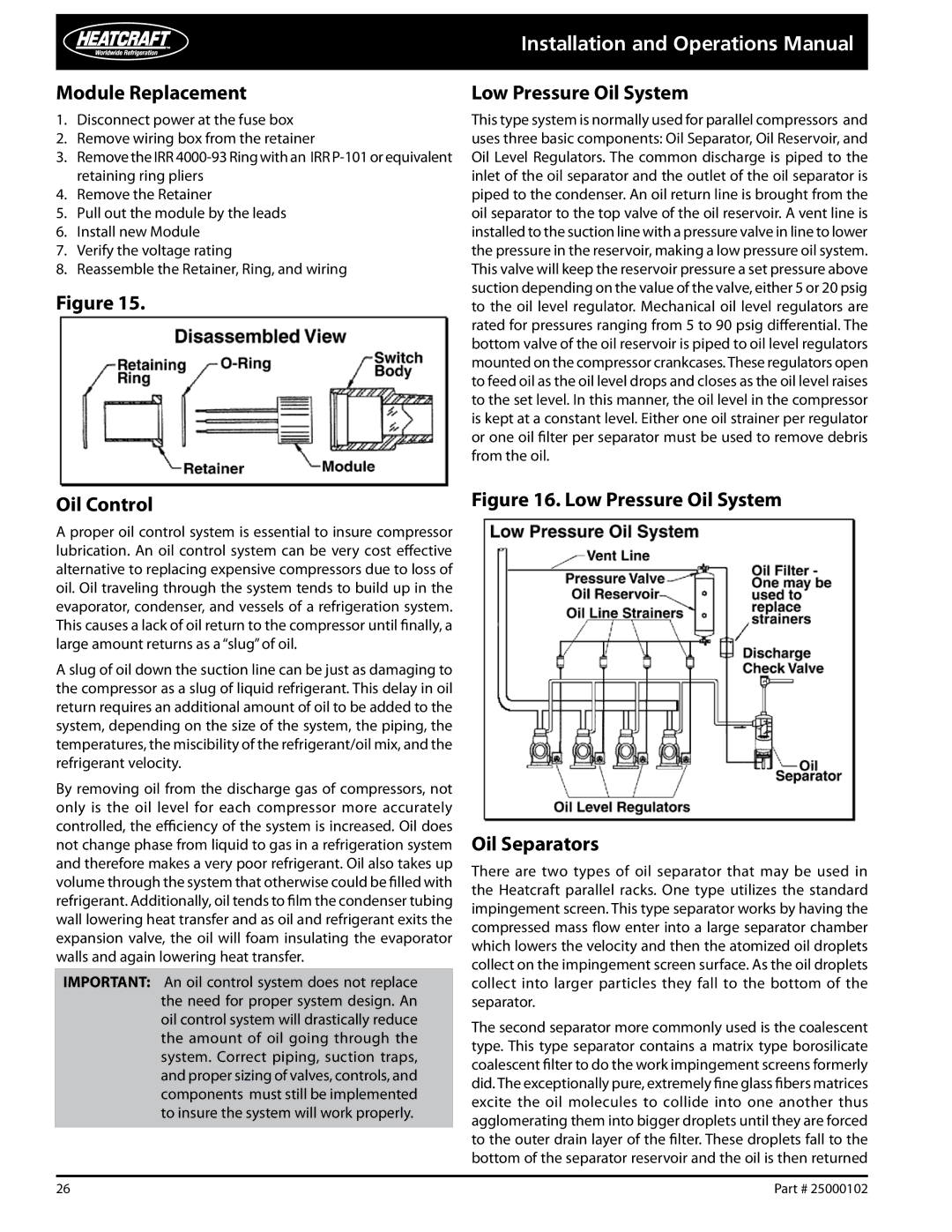
Installation and Operations Manual
Module Replacement | Low Pressure Oil System |
1.Disconnect power at the fuse box
2.Remove wiring box from the retainer
3.Remove the IRR
4.Remove the Retainer
5.Pull out the module by the leads
6.Install new Module
7.Verify the voltage rating
8.Reassemble the Retainer, Ring, and wiring
Figure 15.
Oil Control
This type system is normally used for parallel compressors and uses three basic components: Oil Separator, Oil Reservoir, and Oil Level Regulators. The common discharge is piped to the inlet of the oil separator and the outlet of the oil separator is piped to the condenser. An oil return line is brought from the oil separator to the top valve of the oil reservoir. A vent line is installed to the suction line with a pressure valve in line to lower the pressure in the reservoir, making a low pressure oil system. This valve will keep the reservoir pressure a set pressure above suction depending on the value of the valve, either 5 or 20 psig to the oil level regulator. Mechanical oil level regulators are rated for pressures ranging from 5 to 90 psig differential. The bottom valve of the oil reservoir is piped to oil level regulators mounted on the compressor crankcases. These regulators open to feed oil as the oil level drops and closes as the oil level raises to the set level. In this manner, the oil level in the compressor is kept at a constant level. Either one oil strainer per regulator or one oil filter per separator must be used to remove debris from the oil.
Figure 16. Low Pressure Oil System
A proper oil control system is essential to insure compressor lubrication. An oil control system can be very cost effective alternative to replacing expensive compressors due to loss of oil. Oil traveling through the system tends to build up in the evaporator, condenser, and vessels of a refrigeration system. This causes a lack of oil return to the compressor until finally, a large amount returns as a “slug” of oil.
A slug of oil down the suction line can be just as damaging to the compressor as a slug of liquid refrigerant. This delay in oil return requires an additional amount of oil to be added to the system, depending on the size of the system, the piping, the temperatures, the miscibility of the refrigerant/oil mix, and the refrigerant velocity.
By removing oil from the discharge gas of compressors, not only is the oil level for each compressor more accurately controlled, the efficiency of the system is increased. Oil does not change phase from liquid to gas in a refrigeration system and therefore makes a very poor refrigerant. Oil also takes up volume through the system that otherwise could be filled with refrigerant. Additionally, oil tends to film the condenser tubing wall lowering heat transfer and as oil and refrigerant exits the expansion valve, the oil will foam insulating the evaporator walls and again lowering heat transfer.
IMPORTANT: An oil control system does not replace the need for proper system design. An oil control system will drastically reduce the amount of oil going through the system. Correct piping, suction traps, and proper sizing of valves, controls, and components must still be implemented to insure the system will work properly.
Oil Separators
There are two types of oil separator that may be used in the Heatcraft parallel racks. One type utilizes the standard impingement screen. This type separator works by having the compressed mass flow enter into a large separator chamber which lowers the velocity and then the atomized oil droplets collect on the impingement screen surface. As the oil droplets collect into larger particles they fall to the bottom of the separator.
The second separator more commonly used is the coalescent type. This type separator contains a matrix type borosilicate coalescent filter to do the work impingement screens formerly did. The exceptionally pure, extremely fine glass fibers matrices excite the oil molecules to collide into one another thus agglomerating them into bigger droplets until they are forced to the outer drain layer of the filter. These droplets fall to the bottom of the separator reservoir and the oil is then returned
26 | Part # 25000102 |
